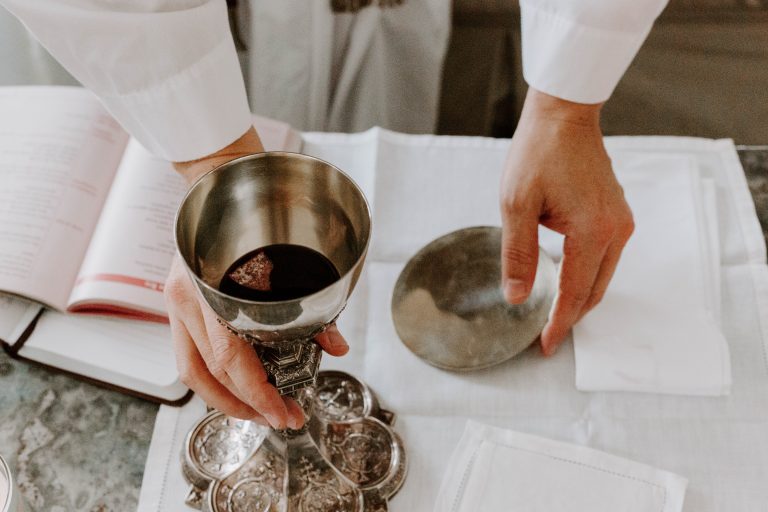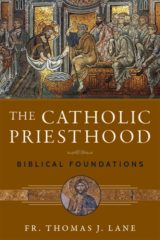By Fr. Thomas J. Lane
Fr. Thomas J. Lane is a priest of the Diocese of Cloyne (Ireland) and is Assistant Professor of Sacred Scripture at Mount St. Mary’s Seminary, Emmitsburg, Maryland. He is the author of The Catholic Priesthood: Biblical Foundations.

The priesthood of Christ and of his apostles and their successors and assistants, who share in Christ’s priesthood, is the answer to the imperfection in the Levitical priesthood of the Old Covenant. Initially, before the Levitical priesthood, the firstborn son functioned as the priest in the family. The Book of Exodus reports that, at Sinai, God limited the priesthood to the descendants of Aaron in the tribe of Levi, although that is generally understood to be the theological understanding of the time when the writing of the Torah was completed. As the centuries passed, discontent with the priesthood grew, very evident in the prophetic texts and in both biblical and extra-biblical texts hoping for a renewed priesthood. Those hopes for a transformed priesthood were fulfilled in Christ, the high priest of the New Testament. The Old Covenant high priest, priest, and Levite are transfigured in the priesthood of Christ, who is the high priest of the New Covenant, and also anticipate typologically the New Covenant ministers (bishop, priests, and deacons).
Christ was not from the priestly tribe of Levi, but rather from the tribe of Judah. Nevertheless, the New Testament hints in a number of places that Christ is a priest, though of a different type, and this becomes explicit in the Letter to the Hebrews, the only New Testament document to state that Christ is a high priest, which it does again and again. The high priesthood of Christ dominates the Letter to the Hebrews, which describes his self-sacrifice on Calvary as the fulfillment of the Yom Kippur liturgy. On that day, the Levitical high priest would enter the Holy of Holies sprinkling animals’ blood to atone for sins, and Hebrews says Christ on Calvary made one single sacrifice and entered God’s heavenly temple. The Holy of Holies in the temple had been forbidden to all except the Levitical high priest (on Yom Kippur), but because of Christ’s once-for-all-time effective sacrifice, Hebrews says all are now invited to God’s heavenly sanctuary and we enter God’s sanctuary by celebrating the Eucharist.
The Gospels show Christ having many disciples, but from them he called twelve who became known as the twelve apostles, and Peter was given the responsibility of leading and unifying. All disciples answer a call from Christ, but these twelve answered a second call from Christ. They were formed into a college, depicted by Mark as an act of creation by Christ. They were sent on temporary mission, already replicating the ministry of Jesus by preaching, exorcising, and healing. Luke alone tells us Jesus also sent out seventy(-two) disciples on a mission, which in many ways was similar to that of the Twelve, and so they anticipate the presbyters in Acts who assisted the apostles, later known as priests who would be co-workers with their bishops.
John 17:17–19 gives us what we might describe as the theology of ordination, as Jesus consecrates the apostles in 17:17 (consecration in Christ the truth), sends them on mission in 17:18, and in 17:19, declares their consecration springs from his own consecration to the Father. Jesus commanding the apostles to “do this in memory of me” during the Last Supper (Luke 22:19) is the Synoptic account of the apostles receiving their priesthood from Jesus. In John 20, Jesus gives his apostles the power to forgive sins after bestowing the Holy Spirit upon them. During Jesus’ last appearance risen from the dead, he commissioned the apostles to minister in his name to the whole world. The Twelve were reconstituted again before the revelation of the Church to the world at Pentecost, and following Pentecost, they continued Jesus’ ministry: what Jesus began to do during his earthly ministry, he continues to do through the apostles after Pentecost.
The New Testament does not employ the word “priest” in reference to the ministers of the New Covenant, since that word denoted the Jewish Levitical priests offering sacrifices in the temple. New terminology was needed. In Jewish Christian churches, the apostles’ assistants were known as presbyters—from which our word “priest” is derived—and the apostles also chose deacons to assist them. Acts 13:1–3 is best understood as Paul’s and Barnabas’ consecration for ministry before they went on mission together. In Paul’s Gentile Christian churches, at first there was a variety of terminology describing those who lead and minister in the name of Christ, but eventually we see the term overseer (episkopos), from which our word “bishop” is indirectly derived. By the time of the Pastoral Epistles, there is a merging of Jewish and Gentile terminology, and we see an ecclesiastical structure developing that anticipates Church structure around the turn of the first century, with a bishop leading a college of presbyters and assisted by deacons. Also in the Pastoral Letters, we see a more developed form of the concept of succession, with ministry being passed on by the laying on of hands that bestows the Holy Spirit. A century later, close to the time of our oldest extant account of an ordination liturgy (beginning of the third century), Tertullian applies priestly language to overseers. The Church is living and growing and developing. Christ had already given everything to the apostles during his ministry, and what we see in subsequent centuries is the unfolding of what is already present in the New Testament.
The development of ecclesiastical structure that we see in the first centuries of the Church is merely making explicit what we already see present in the New Testament. The Catholic Church was founded by Jesus when he chose the apostles and bestowed his priesthood and ministry upon them. The priesthood of the Catholic Church is not an invention after the time of Christ; it is already present in the ministry of Jesus and is the will of God, the will of Christ for us. What Jesus began to do, he continues to do now through his faithful priests ministering in his name, in apostolic succession, in a line that goes back to the apostles and to Jesus himself.
You Might Also Like

During the time of Jesus Christ, neither he nor his apostles would have had the term “priest” applied to their mission or identity. The priesthood was exclusive to the tribe of Levi and at that time was associated primarily with their sacrificial liturgies in the temple. But with Christ’s death on the Cross, a new understanding of Christ as priest began to grow in light of his priestly self-sacrifice. The Catholic Priesthood: Biblical Foundations by Fr. Thomas Lane highlights the Scriptural evidence indicating that Christ’s intention was to establish a New Covenant priesthood that he would share with his apostles and their successors.

